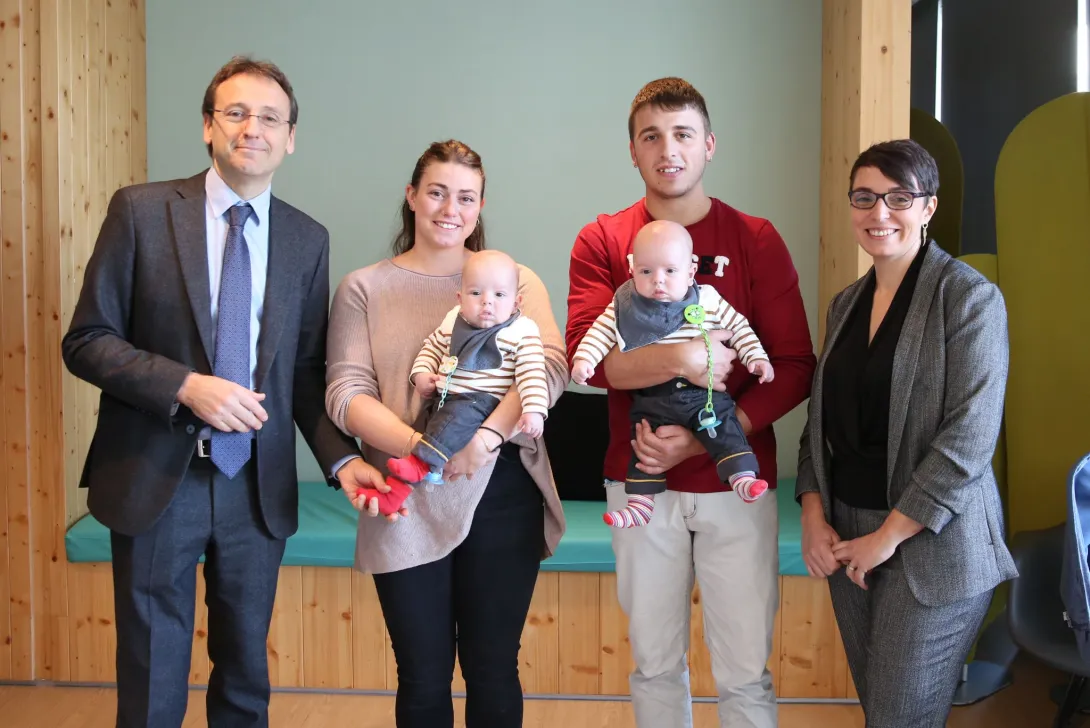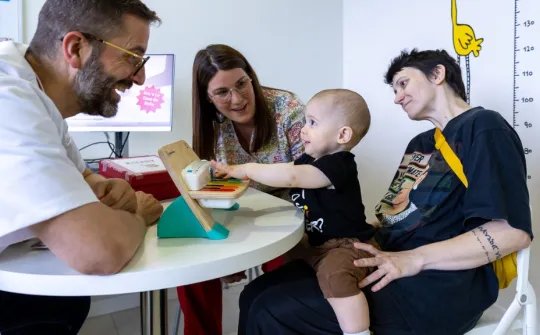Our team of surgeons has extensive experience in the treatment of all types of sIUGR, from milder to the most complex cases.
Pathology description
The condition sIUGR affects 10-15% of monochorionic twin pregnancies. It is characterized by one of the fetuses growing much less than the other, with a size mismatch that is typically more than 25%.
In monochorionic twin pregnancies the twins share a single placenta. In reality, a small portion is shared while most of the placenta is divided with a part for each of the fetuses.
Ideally this division is 50% for each twin and they will have a very similar weight, but sometimes it is very unequal and, for example, one of the twins has 70-80% of the placental territory to itself while the other has only 20-30% of the remaining territory. The latter fetus does not receive the nutrients and oxygen it needs, so it does not grow like its sibling and develops sIUGR.
As all monochorionic twins are connected by blood vessels through their placenta, they exchange blood continuously. In sIUGR this can be both a help and a hindrance:
- It is a help to the small fetus, since the blood that comes from its sibling (with a normal amount of nutrients and oxygen) partly compensates for its small portion of the placenta.
- It can be a hindrance, because as fetuses are connected by their placenta, what happens to one fetus can affect the other. The small fetus may experience a lower heart rate, or, if the sIUGR is very severe, it may even die in utero. If this happens, the normal sibling could lose a lot of blood from the vascular connections and also suffer consequences.
Diagnosis
In many cases, sIUGR can end with good results, but strict and highly specialized monitoring is always necessary. However, there are serious cases in which the evolution is catastrophic, ending with death or severe sequelae for one or both fetuses. This occurs because the way fetuses are connected and exchange blood through the placenta can be very different in each case.
Although many cases of sIUGR progress well, in others there is a very high risk of complications. For many years there was no way to know which cases required treatment and which did not. Today this situation is different thanks to the classification that we developed more than 10 years ago. Thus, although there is no absolutely precise way to know what will happen in each case, fetuses with sIUGR can be classified into three types, which allow a very approximate prediction of the most likely evolution.
The classification is based on observing the blood flow in the umbilical artery of the small, growth restricted fetus with Doppler ultrasound. Briefly, there are three types of sIUGR:
- Type I: The blood flow in the umbilical artery of the growth restricted fetus is normal. These are cases that progress well and it is very rare that they change to type II or III, so the risk of serious complications is low. The most common approach is weekly ultrasound control and birth between week 34 and 36 of gestation.
- Type II: There is very little flow in the umbilical artery of the sIUGR fetus throughout the scan (termed "absent or reverse diastolic flow"). If severity criteria are met, the risk of serious complications is high.
- Type III: The sIUGR twin has a flow similar to type II but intermittently, that is, it appears and disappears throughout the duration of the ultrasound. As in type II, if severity criteria are met, the risk of serious complications is high.
These are the severity criteria for whether an sIUGR type II or III is considered high risk:
- The diagnosis is early (before 24 weeks).
- The discrepancy between the measurements of the abdominal perimeter or the estimated weight of both fetuses is greater than 35%.
- The growth restricted fetus has little amniotic fluid (technically oligohydramnios).
- The flow in the umbilical artery is predominantly reversed and not simply absent.
- There are signs of lack of oxygen or heart failure (such as abnormal Doppler flow in the venous ductus) of the growth restricted fetus.
Treatment
Most cases of sIUGR type I can be monitored with watchful waiting, that is, without doing anything more than monitoring and performing ultrasound controls with Doppler, and will end with a good result.
However, in type II or III cases, especially when all severity criteria are met, the likelihood of severe impairment or death of the growth restricted fetus before 32 weeks is high. This entails a high risk of extreme prematurity and the possibility of injury to the growth restricted fetus, but also to the normal-sized fetus. For this reason it is very important to evaluate cases with sIUGR in centres with high experience in monochorionic gestation. This will make it possible to know the type of sIUGR that is affecting the pregnancy and discuss the best options in your case.
In cases of very high risk, at BCNatal - Sant Joan de Déu we offer the possibility of treatment with fetal surgery by laser fetoscopy to completely separate the circulations between the two twins and stop their connections, in a similar way to how Twin to Twin Transfusion Syndrome is treated.
In this way, although the treatment will not be able to reverse the problem of the delay of the growth restricted fetus, it will serve to significantly protect the normal-sized fetus from consequences in terms of prematurity, survival and sequelae in case there is a serious deterioration or death of the growth restricted fetus.
It should be noted that these fetoscopies are much more difficult than those performed to treat TTTS, and the experience of the surgeon is even more important to obtain good results.
What appointments are needed for fetal surgery?
The in-patient admission of the pregnant woman will initially last 1-2 days, maintain a low-activity lifestyle mainly at home until the end of pregnancy, especially for the first 3-4 weeks after the intervention. Normally, delivery can be performed between 34 and 36 weeks of gestation.
During pregnancy, you will receive the support of nurses specialized in fetal medicine, not only on a technical level but also on an emotional level throughout the process. In addition, we can put you in contact with other families who have gone through the same experience. This is very positive and helps to humanize and understand the problem in a much more intuitive way and without the difficulties that sometimes arise when receiving only technical information from professionals.

Why BCNatal - SJD?
For parents who wish to continue their pregnancy care and have their baby with us, we offer a fetal surgery team with the best survival and quality of life figures that can currently be obtained.
We have more than 20 years’ experience and have evaluated thousands of cases.
Experience and efficiency
We have more than 20 years’ experience and have evaluated thousands of cases.
- We have also been pioneers in the treatment of these complications by fetal surgery for the most severe type II and III cases.
- At this time, our experience comprises more than 500 severe sIUGR surgeries.
- ur surgical times have been published in scientific journals and are among the lowest
- We have a lot of experience in the different options that can be considered and have published some of the largest collections in the medical literature. Not all cases of sIUGR need treatment, but if needed, fetal surgery for sIUGR is much more difficult than that offered for other complications such as TTTS
We are pioneers in the study of such pregnancies, having carried out the first investigations that showed how it was possible to identify the cases with the worst prognosis.
Commitment to research
We are pioneers in the study of such pregnancies, having carried out the first investigations that showed how it was possible to identify the cases with the worst prognosis.
- Our classification of selective restricted intrauterine growth (sIUGR) is a reference since it is that currently used internationally.
- We have published some of the largest collections in the medical literature.
- We have recently refined an endoscopic surgical technique for complications of monochorionic twins, integrating navigation and robotics tools and technologies that allow greater precision and speed during surgery, thus reducing the associated complications.
